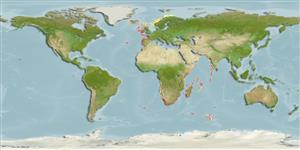Пластиножаберные (акулы и скаты) (sharks and rays) >
Squaliformes (Sleeper and dogfish sharks) >
Squalidae (Dogfish sharks)
Etymology: Squalus: Genus name from Latin 'squalus' meaning shark (Ref. 6885, 27436); margaretsmithae: Named for Professor Margaret Mary Smith, first director of the former J.L.B. Smith Institute (currently
SAIAB)..
Environment: milieu / climate zone / depth range / distribution range
экология
морской; пределы глубины 256 - 284 m (Ref. 116247). Tropical
Eastern Atlantic Ocean from Portugal and Morocco to South Africa.
Size / Вес / Возраст
Maturity: Lm ? range ? - ? cm
Max length : 54.3 cm TL самец/пол неопределен; (Ref. 116247)
Краткое описание
морфология | морфометрия
позвонки: 107 - 115. This species is distinguished from its regional congeners (except S. acutipinnis) by having broad pectoral fins that transcend trunk height when adpressed on body, with length of pectoral fin anterior margin 16.5%, 15.9-17.9% TL; differs from S. chloroculus, S. edmundsi, S. lalannei, S. mitsukurii, S. montalbani, S. nasutus by having a smaller snout with prenarial length shorter than distance from nostril to upper labial furrow, and unicuspid and lanceolate dermal denticles (vs. prenarial length greater than distance from nostril to upper labial furrow, and tricuspid and rhomboid dermal denticles); differs from S. megalops, S. brevirostris by having postventral caudal margins that are not uniformly white (vs. postventral caudal margins uniformly white in megalops, brevirostris). differs from S. mahia by having dermal denticles that are wide at the crown (vs. dermal denticles slender at crown in megalops, mahia); differs from S. brevirostris, S. crassispinus by having a shorter dorsal-caudal space, 11.2%, 10.8-12.2% TL (vs. 10.1-10.6% for brevirostris and 9.9-10.0% TL for crassispinus), and from S. mahia, S. crassispinus by the prespiracular length 11.5% TL, 11.7-12.3% TL (vs. 12.4%, 12.4-13.9% TL for mahia and 12.5-12.7% TL for crassispinus); further differs from S. crassispinus by its shorter preorbital length, 6.5%, 6.4-7.0% TL (vs. 7.3-7.4% TL), its larger pectoral fins with pectoral fin inner margin length 9.7%, 9.2-10.6% TL (vs. 8.6% TL), its pectoral fin posterior margin length 11.3%, 11.8-14.5% TL (vs. 9.0-9.4% TL), greater pre-first dorsal fin length, 28.2%, 28.1-32.2% TL (vs. 26.7-27.4% TL), its wider mouth, its widhe 7.6%, 7.8-9.0% TL (vs. 7.4% TL), and shorter pelvic-caudal distance, 25.1%, 24.9-27.2% TL (vs. 27.9-28.1% TL); differs from S. acutipinnis by having a first dorsal fin somewhat upright and rounded at apex, its posterior margin concave at its midline (vs. fin prone and pointed at apex, its posterior margin straight throughout in), caudal fork between lobes discontinuous (vs. continuous), dermal denticles with length greater than width and symmetrical lateral expansions (vs. dermal denticles somewhat equal in length and width, and asymmetrical lateral expansions), its upper teeth narrow, lower teeth depressed, cusp very short and somewhat oblique, straight mesial cutting edge, rounded mesial heel, and apron very short in both jaws (vs. upper teeth broad, lower teeth tall, cusp elongate and directed upward, concave mesial cutting edge, constricted mesial heel, and apron shorter only in upper teeth) (Ref. 116247).
Life cycle and mating behavior
половая зрелость | размножение | нерест | икра | Fecundity | личинки
Viana, S.T. d. F.L., M.W. Lisher and M.R. de Carvalho, 2017. Two new species of short-snouted dogfish sharks of the genus Squalus Linnaeus, 1758, from southern Africa (Chondrichthyes: Squaliformes: Squalidae). Mar. Biodiv. 1-28. (Ref. 116247)
Статус Красного Списка МСОП (Ref. 130435)
Угроза для людей
Harmless
Использование человеком
дополнительная информация
народные названиясинонимыобмен веществхищникиэкотоксикологияразмножениеполовая зрелостьнерестSpawning aggregationFecundityикраРазвитие икры
Возраст/РазмерыростЗависимость между длиной и массой телаЗависимость между длинамиРазмерный составморфометрияморфологияличинкидинамика численности личинокпополнениечисленностьBRUVS
ссылкиаквакультура (рыбоводство)особенности рыбоводствастепень растяжениягенетикаElectrophoresesнаследуемостьболезниобработкаNutrientsMass conversion
соавторыизображенияStamps, Coins Misc.звукиCiguateraскоростьтип плаванияжаберная областьOtolithsмозгзрение
инструменты
Специальные отчеты
Скачать в формате XML
ресурсы в Интернет
Estimates based on models
Phylogenetic diversity index (Ref.
82804): PD
50 = 0.5000 [Uniqueness, from 0.5 = low to 2.0 = high].
Bayesian length-weight: a=0.00339 (0.00162 - 0.00707), b=3.10 (2.93 - 3.27), in cm total length, based on LWR estimates for this Genus-body shape (Ref.
93245).
Trophic level (Ref.
69278): 4.2 ±0.3 se; based on size and trophs of closest relatives
устойчивость к внешним воздействиям (Ref.
120179): низкий, минимальное время удвоения популяции 4.5-14 лет (Preliminary K or Fecundity.).
Fishing Vulnerability (Ref.
59153): Moderate vulnerability (42 of 100).
